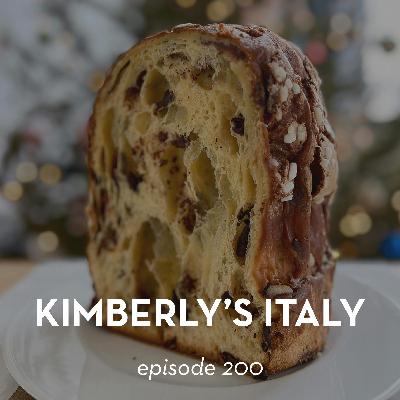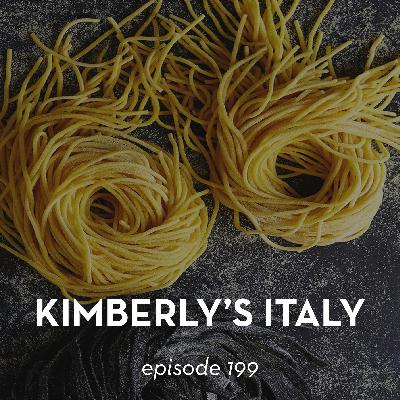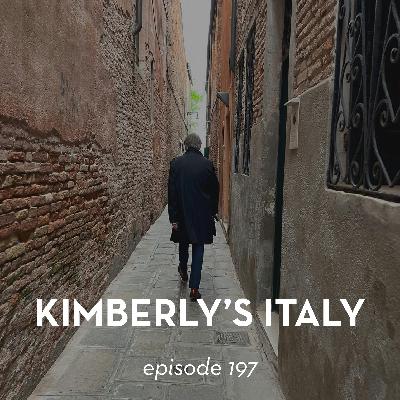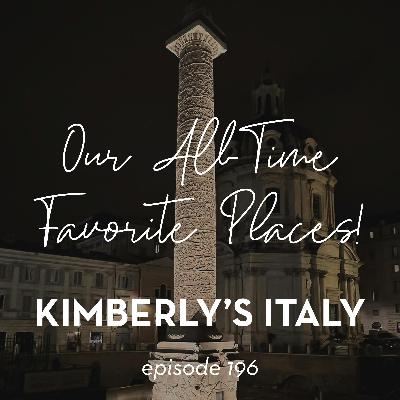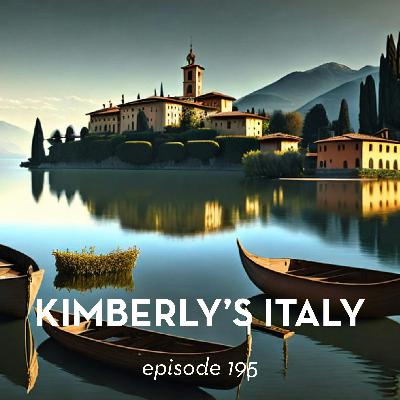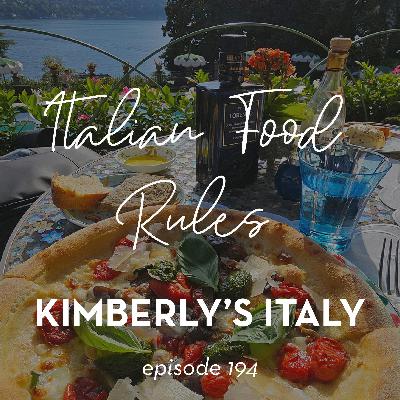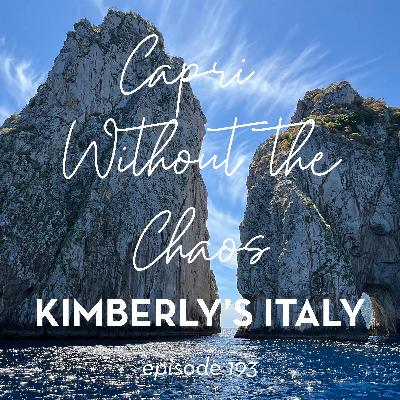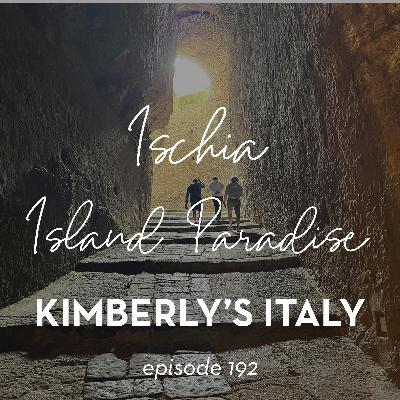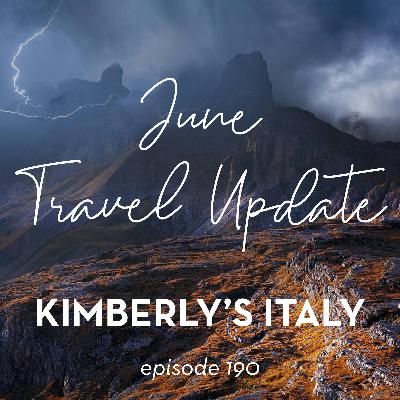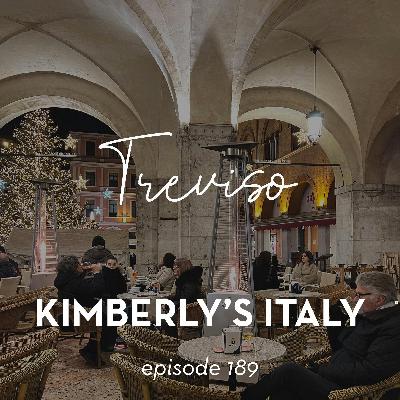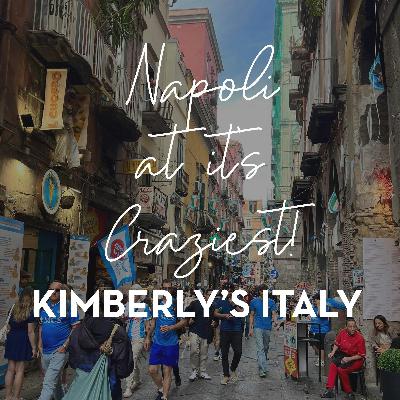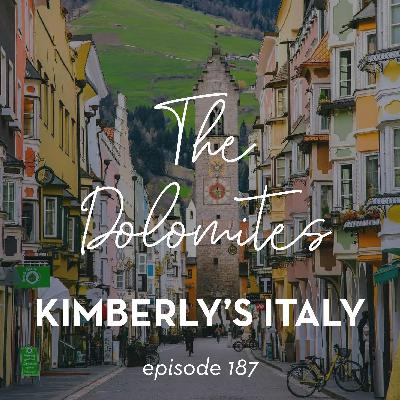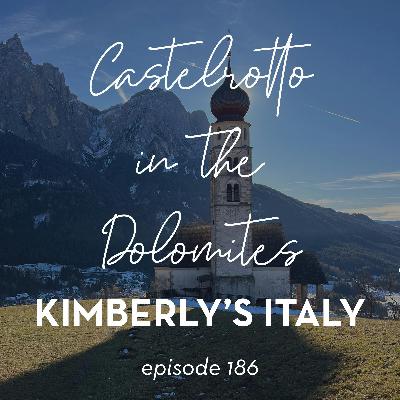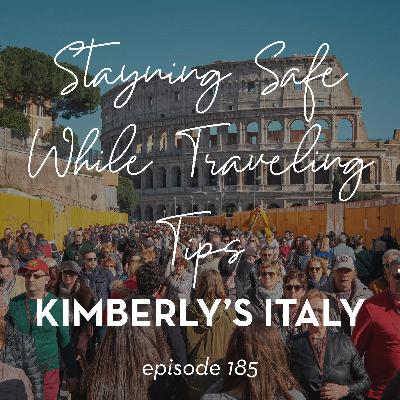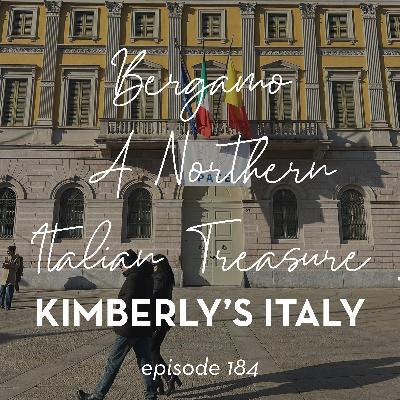Discover Kimberly's Italy Travel
Kimberly's Italy Travel

Kimberly's Italy Travel
Author: Kimberly Holcombe
Subscribed: 49Played: 1,611Subscribe
Share
© 2023 Kimberly's Italy, LLC
Description
Welcome to Kimberly's Italy, a travel podcast focused on all things Italian. My love affair with Italy started with a move to Milan many years ago, and the enriching experience became part of my DNA. Our episodes highlight some of our own travels and the comical lessons we learned along the way. You can be the beneficiary of invaluable travel tips, and at the same time enjoy a few laughs. We share our passion of the Italian cuisine, history, art, architecture, and the welcoming nature of the Italian people, whom define this incredible country. You can reach me at: Kimberlysitaly.com
213 Episodes
Reverse
Please Follow us on: Instagram or Facebook !
In this special 200th episode, Kimberly and Tommaso celebrate a milestone while discussing their upcoming move to Italy. They share insights into Italian holiday traditions and meals, offering a look at how these differ from American celebrations.
Key Points:
The Podcast’s Journey:
Kimberly and Tommaso il Favoloso reflect on 200 episodes of their podcast which they started during COVID..
Their podcast’s goal has always been to share their love of Italy and offer travel insights.
Future plans include returning to a weekly episode schedule after their move to Italy.
Thanksgiving in America vs. Holidays in Italy:
Kimberly describes the traditional American Thanksgiving meal, which has remained largely unchanged for 400 years.
Tommaso shares his enjoyment of the Thanksgiving meal.
The conversation shifts to Italian holiday meals, highlighting their variety and cultural significance.
Visiting Italy during a holiday offers a chance to experience unique traditions and less crowded destinations.
Italian Christmas Eve (La Vigilia):
Most Europeans celebrate Christmas on Christmas Eve with their main meal.
The traditional Christmas Eve meal in Italy is seafood, a “lean day” without meat.
Italian Christmas Eve dinner begins early with aperitivo, followed by antipasti (no meat), pasta or risotto and fish as the main course.
Desserts include panettone, pandoro and torrone.
Kimberly recounts loud, lively Christmas Eve dinners in Milan with extended family.
Italian Easter (Pasqua):
For Easter, Italians eat lamb, not ham.
The day starts with Colomba, a dove-shaped, sweeter version of panettone, symbolizing peace and rebirth.
Eggs are important, appearing in dishes like torta pasqualina and brodetto pasquale.
Artichokes, asparagus, or chicory accompany the lamb.
A popular dessert is pastiera napolitana, a creamy, sweet cake from Naples.
Other Italian Holidays:
Italy celebrates several non-religious holidays, such as Liberation Day and Festa della Repubblica.
Religious holidays like Ognissanti on November 1st involves eating Pane de Morti (bread of the dead).
New Year’s Eve (Capodanno) is a religious holiday focused on symbolic foods for luck and prosperity.
Old school Italians eat 12 grapes at midnight for luck in each month of the year.
Epifania (Epiphany) on January 6th, marks the end of the Christmas season and includes a fun tradition with La Befana, a kind witch who brings treats.
Celebrations for La Befana include a regatta in Venice and a national festival in Urbania
Planning Your Trip:
Experiencing Italian holidays offers a chance to enjoy different cultural traditions and foods.
Agriturismos or small family-run hotels are ideal for experiencing traditional holiday meals.
Join us in this episode as we uncover the true essence of Italian holiday traditions, providing a realistic and enriching perspective on what to expect and enjoy.
Please Follow us on: Instagram or Facebook !
In this episode, Kimberly and Tommaso apologize for the delay in their latest release. They then dive into a discussion about their favorite meals in Italy, looking back at 28 years of travel.
Key Points:
Kimberly and Tommaso offer a sincere apology for the delayed episode.
They recap their previous discussion on favorite cities and regions.
The main topic is their favorite meals in Italy, spanning 28 years of travel experiences.
Episode Highlight: First Italian Meals in Cervinia
Kimberly and Tommaso recount a ski trip from Zermatt, Switzerland, down to Cervinia, Italy.
Kimberly describes their incredible hunger after the challenging ski descent.
Tommaso recalls his memorable Zuppa Valdostana, a rich beef broth soup with bread and fontina cheese.
Kimberly shares her delight in eating polenta with fontina cheese and red wine.
They reminisce about a Raclette lunch with Matterhorn views, marking it as a beautiful outdoor dining experience.
Meals in Lago di Como and Florence:
Kimberly shares a story about visiting friends in Lago di Como, coinciding with their annual Brunello bottling celebration.
Tommaso describes enjoying five to seven-year-old Brunello with grilled beef prepared by an international meat dealer.
Kimberly celebrates her 40th birthday lunch at Alvalu in Tremezzo, featuring simple tomato pasta, cured meats, and a beautiful fruit tart.
They both recall the unique grappa infused with blueberries, made by monks.
Rome and Florence Culinary Experiences:
Tommaso shares his first carbonara experience in Rome in 2021, describing it as a moment of pure paradise.
Tommaso notes the relaxed dining pace in Italy, contrasting it with the faster pace in America.
Kimberly describes a simple, attractive enoteca in Rome where they enjoyed another carbonara and a mozzarella di bufala appetizer.
Tommaso discusses his anticipation and enjoyment of Bisteca Fiorentina in Florence, splitting it with a friend.
Kimberly remembers the bright and loud atmosphere of the Florentine restaurant, a contrast to their preferred dining setting.
Southern Italy and Pizza Delights:
Kimberly highlights her favorite meals in Puglia, particularly a salad with tuna, mozzarella, and local vegetables, drizzled with Puglian olive oil and served with local bread.
Tommaso praises the simplicity and quality of Puglian bread.
Tommaso declares his favorite pizza was in Ischia, preferring a heartier style with onions, mushrooms, and prosciutto.
Kimberly recounts a standout Napolitano pizza experience in Torino, found in a residential neighborhood across the river.
Tommaso reflects on the ongoing challenge of finding the “next best something” in Italian cuisine.
Coffee and Truffles in Torino:
Kimberly raves about the bicherine, a coffee layered with dark chocolate, espresso, and frothy cream, at Cafe Bicherine in Torino.
Tommaso praises a wide noodle pasta with shaved white truffles, enjoyed during truffle season in Torino, paired with a bottle of Barolo.
Join Kimberly and Tommaso as they revisit their most cherished Italian meals, sharing anecdotes and insights from decades of culinary adventures.
Kimberly and Tommaso share their most memorable meals from 28 years of Italian travels, from ski trips to Roman trattorias. This episode explores Italy’s diverse culinary landscape and the joy of savoring food and culture.
Please Follow us on: Instagram or Facebook !
In this episode, Kimberly and Tommaso continue their discussion of favorite places in Italy. They add a beloved city to their list and share favorite countryside regions
Favorite Cities: Adding Venezia
Beyond the Crowds: Kimberly and Tommaso admit Venice can be crowded. They share how to see it in a less crowded way, even during high season. Knowing where to stay and when to visit certain spots helps.
A Unique City: Venice is unlike any other city. It feels enchanting, otherworldly. Walking narrow alleyways (calli) transports visitors back centuries.
Engineering Marvel: The city’s ingenious foundation system uses wooden pilings. These pilings are now as hard as concrete because they were oxygen-deprived for centuries.
Historical Achievements: Tommaso shares Venice’s contributions to Western civilization.
Early system of checks and balances in government (675 A.D.).
The Arsenal shipyard, the world’s largest industrial complex before the Industrial Revolution (1104 AD).
First street lighting ordinance (1128 AD).
First state-guaranteed national bank (1157 AD).
Invention of the elevator (1160 AD) for the Piazza San Marco bell tower.
First government bonds (1171 AD) from forced citizen loans.
The bill of exchange for international trade (around 1200 AD).
Infused soap, inventing perfume and deodorant (1200s).
First brick hearth with a chimney and flue (1227 AD).
First child labor laws (1284 AD) for Murano glass production.
Returning to Venice: Tommaso is a serious fan, therefore he plans on many returns.
Favorite Countryside Regions
The Dolomites:
Kimberly’s History: She has a long history of hiking trails and staying in refugios. She recalls picnics with friends in alpine meadows. Skiing was a frequent activity.
Tommaso’s First Visit: His first visit was last December. He notes the unique, jagged peaks compared to US mountains.
Cuisine and Air: The Dolomites offer high-end, creative cuisine and excellent wines. The fresh mountain air is invigorating.
Toscana: Val d’Orcia:
Picture-Perfect Landscape: This area in southeast Tuscany is idyllic. It resembles a painting or a movie set. It defines what many imagine when they hear “Tuscany.”
UNESCO Status: Recognized in 2004, Val d’Orcia is a cultural landscape shaped by humans in harmony with nature. This status ensures its visual preservation. No modern buildings or businesses will alter its appearance.
Medieval Villages: The area has authentic villages like Montepulciano, Pienza, and Montalcino. Locals live in these villages so it’s not just a tourist destination.
Winding Roads: Narrow, two-lane roads without shoulders connect the villages. This maintains the beauty. Lack of streetlights at night makes driving challenging for non-locals.
Wine and Food: Home to famous wines like Brunello and Vino Nobile di Montepulciano. The cuisine features cured meats, ragu sauces, and pici pasta.
Puglia:
Distinct Landscape: Puglia stands out geographically. It resembles Greece, Turkey, or even the central Australian desert with its burnt orange soil.
Architecture: The stark white Trulli buildings and Masserias contrast with the colorful soil. This creates a unique landscape.
Kimberly’s Favorite Cuisine: Puglia’s cuisine is Kimberly’s favorite in Italy. They use many vegetables in dishes. These vegetables grow in the region’s rich soil.
Wines and Bread: The region produces diverse, full-bodied wines such as Primitivo and Negroamaro. Tommaso notes that their friend “Breadbasket Bridget,” claims Puglia has the world’s best bread.
Growing Popularity: Puglia offers fewer crowds, different cuisine and wines, and unique places to stay. The refreshing sea breeze adds to its appeal.
Kimberly and Tommaso plan to discuss their favorite experiences or meals in the next episode.
Please Follow us on: Instagram or Facebook !
Kimberly and Tommaso discuss their all-time favorite places
in Italy. They reminisce about past travels and discuss their favorite islands,
lakes, and cities.
Key Points:
Favorite Islands:
Kimberly loves Capri of the raw beautKimberly’s favorite is Lake Como due to her long-standing history with it and it’s idyllic old villas against the backdrop of the mountains.
Tommaso’s first visit to Sardinia was for a sailing regatta and he’s been hooked ever since. Sailing between the northern tip the island and the southern tip of Corsica is the most beautiful geography he’s ever seen
Favorite Lakes:
Kimberly’s favorite is Lake Como due to her long-standing history with it and it’s idyllic old villas against the backdrop of the mountains.
Tommaso prefers Lake Garda, citing its Venetian influence in architecture, grander size, and naturally the sailing.
Favorite Cities:
Both agree that Rome is addictive due to its architecture, history, and vibrant atmosphere, not to mention the cuisine and friendly locals.
Tommaso also loves Bologna for its manageable size, architecture and academic history. Throw in Ragu Bolognese and all is good in the world.
Episode Insights:
Tommaso appreciates the large size and large vistas on Lake Garda. He describes the stunning drive around the lake and the dramatic weather systems which add to the visual.
Kimberly and Tommaso enjoy walking around Rome at night to see the various centuries of architecture lit so dramatically by the exterior lighting.
Tommaso loves Bologna for its architecture and its historical influence with academia, science and medicine
Kimberly and Tommaso suggest seeing the island of Sardinia by both boat and Vespa, or at least a small car to get a feel for the curvy coastline.
Next Episode:
Kimberly and Tommaso will continue their list of top 10 favorite places in Italy, including their favorite countryside destinations.
Apologies !
Please Follow us on: Instagram or Facebook !
In this episode of Kimberly’s Italy, Kimberly and Tommaso discuss topics from tourism’s impact on the Dolomite mountains to online travel scams and cybersecurity issues.
Key Points:
Summer in Italy:
Italians love the summer season for the outdoor activities like festivals, concerts, and dining.
Many Italians consider summer their favorite season since they love the sun, the beach and swimming.
Over-Tourism in the Dolomites:
Mass tourism is impacting the Dolomite Mountains.
Overcrowding is causing damage to private lands, leading to disputes between landowners and tourism groups.
Farmers started charging fees to access paths on their property to make a point, and a cry for help.
AI and Travel Planning:
YouTube is facing a rise in AI-generated content, or “slop,” affecting travel information.
AI-generated videos are tricking tourists into visiting non-existent places.
There have been instances of AI scams causing disappointment for travelers.
It’s important to double-check travel information found online.
Cybersecurity - Juice Jacking:
Juice jacking is a threat where malware is embedded in public USB ports.
Travelers are advised not to use airport USB chargers to avoid malware infections.
The use of portable power chargers is recommended.
Public Wi-Fi networks in airports can be unsecured and targeted by hackers.
Final Thoughts:
Don’t be discouraged from the extra amount of travel planning due to unreliable information since it will be worth the effort when you are finally in bel’italia!
Be prepared and informed about the latest developments with AI and misleading imagery.
Please Follow us on: Instagram or Facebook !
In this episode, Kimberly and Tommaso discuss the significance of preserving Italian recipes and the consequences of not adhering to culinary traditions.
Pizza Napolitana and the AVPN:
The hosts introduce the Associazione Verace Pizza Napolitana (AVPN), an organization dedicated to preserving the authentic technique of pizza making in Naples.
They discuss the specific requirements for cooking certified pizzas, including dough preparation, cooking time, and ingredients.
The AVPN employs “pizza agents” to ensure compliance with standards, risking delisting for non-compliant pizzerias.
Cacio e Pepe Controversy:
A British website, UK Good Food, published a recipe for Cacio e Pepe with incorrect ingredients, sparking outrage among Italians.
The recipe included butter and parmigiano, deviating from the traditional ingredients of pasta, pepper and pecorino
The President of Italy’s Restaurant Association sent a letter to UK Good Food, leading to a comical turn of events, but finally an acknowledgement of the correct recipe.
Italian Pride in Traditional Recipes:
Cuisine bonds Italians to each other, with recipes handed down by generations.
Italians take deep pleasure in preparing their meals slowly and with the best ingredients possible. They don’t just consume a meal, they linger and enjoy it, and talk about it!
Italy’s efforts to respect and protect specific foods and recipes through organizations like the DOP are admirable
Link to Pizza Police Site:
Here is link to the AVPN website which explains the school and lists the certified pizzerias around the world.
https://www.pizzanapoletana.org
Please Follow us on: Instagram or Facebook !
In this episode of our podcast, Kimberly and Tommaso share tips on visiting the island of Capri, including accommodations, activities, and dining experiences. They highlight how to make the most of a trip to Capri.
Key Points:
Planning Your Trip to Capri:
Begin looking for accommodations in the summer before your trip, especially if traveling in the summer months.
Consider staying slightly away from the main piazza to avoid crowds.
Use Kimberly’s tip for navigating crowded areas: designate a meeting spot.
The Two Villages on the Island:
Capri has two villages: Capri and Anacapri.
Anacapri offers a more tranquil experience but still has plenty of choice.
Capri is more well-known from its history of a celebrity hotspot, but a lovely village at the same time.
Activities and Sights:
Take advantage of the island’s many walking paths for stunning views and historical sites.
Take a chairlift to the top of Monte Solaro for incredible views.
Visit the Gardens of Augustus.
Walk Via Krupp, which recently reopened after repairs.
Explore Villa Jovis.
Walk the Pizzolungo path for the best views of the Faraglioni rocks.
Discover the Charterhouse of San Giacomo, a 14th-century monastery.
Boating Around Capri:
Consider renting a traditional wooden gozzo or choose from a variety of motorboats and sailboats.
Private boats stop at the best swimming spots as you cruise around the island.
Being on any type of boat provides a unique perspective of the Faraglioni rocks.
Capri Cuisine:
Capri offers sophisticated dining experiences with beautifully presented dishes.
Seafood reigns here but you can find a wide variety to choose from.
Capri Rooftop offers a trendy lounge experience with views of the Faraglioni
Please Follow us on:
Instagram
Facebook
Kimberly and Tommaso share their adventures on the island of Ischia, from a comical car rental experience to a serene beach day. They address weather concerns for travelers and offer tips for visiting historical sites.
Weather Concerns and Travel Advice:
Kimberly and Tommaso respond to a review criticizing their warnings about extreme weather in Europe.
They cite publications like Euro News, The Guardian, and the BBC who also address the issue and give advice as well.
They stress the importance of sharing this information since it is affecting tourism to Italy and all of Europe.
The Moke Adventure:
Tommaso recounts a funny car rental experience involving an old moke with no seat belts, functioning windshield wipers or directionals.
The drive to Castello Aragonese was challenging, with difficult roads and a tricky clutch.
Kimberly and Tommaso always drive throughout Italy, but this particular day just wasn't enjoyable.
Castello Aragonese and Travel Tips:
Kimberly shares a travel tip regarding printed brochures at historical sites for accurate information.
The history of Castello Aragonese is explored, noting its construction in 474 B.C. and subsequent rulers.
By the 16th century, the island was home to nearly 1,900 families, nuns, and priests.
The well-organized visit includes various structures and spaces, all of them impressive.
Beach Day:
Due to the challenging drive, they canceled the next day’s rental and opted for a beach day at Lido di Moronti.
Beach Day at Lido di Maronti:
They took a water taxi to the beach and were happily surprised at the reasonably priced beach clubs.
The day included reading, swimming, and a flavorful lunch with fresh ingredients.
Despite some crabby water taxi drivers, the beach day was a highlight of the trip.
Future Plans:
The next episode will cover their amazing time in Capri, including a boat tour around the island.
Please Follow us on:
Instagram
Facebook
Kimberly and Tommaso share their experiences on the island of Ischia, near Napoli, Italy. They discuss Ischia’s geography, history, cuisine, beaches and the island’s appeal.
Key Points:
Initial Impressions of Ischia:
Kimberly revisits Ischia after 30 years since her last visit, noting its idyllic scenery and vibrant colors.
Tommaso recalls having the best pizza of his life upon arrival.
Ischia is relatively small, about 46 square kilometers, yet offers diverse landscapes.
Geography and Driving Challenges:
The island has one main ring road, making travel slow due to curves and narrow roads.
Driving can be difficult due to log jams caused by buses and parked cars.
Kimberly and Tommaso canceled their rental car after one day due to the intense driving conditions.
Historical and Geographical Makeup:
Ischia is a volcanic island with fertile soil, home to diverse Mediterranean plants.
The island was first inhabited by Greeks in the 8th century B.C.
The Aragonese castle, built in 474 B.C., is a significant historical site.
Tourism and Local Life:
Ischia has a population of 60,000 residents and attracts 6 million tourists annually.
The island offers a variety of accommodations from resorts to hotels in condensed villages.
The cuisine is seafood-heavy, with excellent pizza and salads.
Beaches and Weather:
Ischia boasts sandy beaches, a unique feature compared to other islands like Capri.
The island’s beaches are a major draw for mainland Italians.
Tommaso provides a weather update, noting the extreme heat in Italy and warmer-than-usual Mediterranean temperatures.
They advise listeners to stay hydrated and prepared for the heat.
Next Episode:
Kimberly and Tommaso will share the challenging but funny driving experience, as well their very interesting visit to the Aragonese Castle and luxurious day at a beach club.
Please Follow us on:
Instagram
Facebook
Core Points of this episode:
Be sure to thoroughly research online travel information; verify details before making plans, as social media posts and other sources can be misleading.
Be aware of potential tourist scams, like fake petitions, and exercise caution when approached by strangers requesting signatures or donations.
Respect art and cultural sites by refraining from disruptive behavior such as taking selfies or not paying attention to what is part of a museum exhibit.
Prepare for extreme weather, including heat waves and intense storms, by staying updated on forecasts and having plans for seeking shelter.
Anticipate possible travel disruptions due to strikes, especially during peak season, and check for updates from transport operators.
Remember to register your travel plans with your government’s traveler enrollment program for safety alerts and advisories.
Summary
Travel Information and Misleading Content
Kimberly and Tommaso emphasize the importance of verifying travel information found online. A humorous example is shared of an Instagram video showing a pharmacy sign in Rome displaying a false temperature of 46 degrees Celsius. This highlights how easily social media can spread misinformation, prompting listeners to be skeptical.
Tourist Scams and Ethical Behavior
We bring attention to tourist scams encountered in Italy, such as people with clipboards seeking signatures for a fake charity petition, later soliciting donations from those who sign. Kimberly and Tommaso also discuss the importance of respecting art and cultural sites. Examples of tourists causing damage, such as a couple breaking a crystal chair in a museum and a man falling into a painting at the Uffizi Gallery, highlight the need for visitors to be mindful and respectful of their surroundings.
Weather Conditions and Preparedness
The current hot weather in Italy and the likelihood of intense storms, especially in northern Italy, are discussed in detail. Kimberly and Tommaso advise travelers to plan for unexpected weather changes, as storms can come in quickly and cause flooding. They suggest seeking shelter during storms and adapting sightseeing plans to avoid the hottest parts of the day, such as lingering over lunch.
Travel Disruptions Due to Strikes
We provide information about potential transportation strikes in Italy. These strikes may affect train services and airport operations, with specific dates and times provided for planned actions. It is recommended to check for updates from train and airport operators closer to the travel dates to mitigate potential disruptions.
Travel Advisories and Safety
We share updates on travel authorization requirements, noting delays in implementing the ETIAS and EES systems. They also mention the U.S. State Department’s travel advisory regarding the conflict between Israel and Iran and potential demonstrations against U.S. citizens. This prompts listeners to register their travel plans with their government’s traveler enrollment program for safety alerts and advisories.
In this episode, Kimberly and Tommaso share their experiences in Treviso, Italy, offering travel tips and historical insights. They explore Treviso’s charm, cuisine, and proximity to other Italian destinations.
Key Points:
Treviso: An Unheralded Italian Gem:
Treviso is near Venice, offering similar canals and architecture but with fewer tourists.
Despite attracting hundreds of thousands of visitors, it remains less crowded than Venice.
Treviso’s blend of canals, medieval palaces and colorful facades create a visually appealing experience.
Travel Tip: Photograph Everything:
Document rental car damage with photos of the car, the other driver’s information, and interactions with rental agencies.
This precaution can help resolve potential disputes with rental car companies.
Historical and Cultural Highlights:
Porta San Tommaso: An ornate gate featuring the Venetian lion, showcasing the city’s history.
Fontana Delle Tette: The Fountain of Breasts, a sculpture that once spouted wine during the election of a new mayor, symbolizing the city’s rich past.
Cuisine and Wine of Treviso:
Prosecco: The popular wine of the Veneto region, with vine-covered hills recognized as UNESCO World Heritage sites.
Incrocio Manzoni: A local white wine similar to Riesling, enhancing the region’s diverse wine offerings.
Tiramisu: Treviso is the birthplace of tiramisu, first introduced on a menu in 1972 at the restaurant Le Becchiere.
Episode Highlights:
Memorable aperitivo experiences include both elegant settings under arcades and laid-back atmospheres.
Treviso is a great base for visiting vineyards, Padova, Vicenza, Trieste, and the Dolomites.
Staying in Treviso offers a less crowded and more authentic experience compared to Venice, especially in the off season.
In this episode, Kimberly and Tommaso share travel tips and tales from Naples / Napoli and its surrounding islands. They recount Tommaso’s first chaotic yet enlightening experiences in Napoli.
Key Points:
• Train Travel Tips: Finding your train number on digital displays on the train doors.
• Business Class: A worthwhile upgrade for comfortable travel from Verona to Naples.
• Taxi Travel: Use the designated taxi stand to avoid scams.
Naples Experiences:
• Chaotic Driving: First impressions of Napoli’s’ traffic mayhem. Lane markers and traffic signals? Just suggestions.
• Sensory Overload: A city full of graffiti, scooters, and constant activity.
Memorable Moments:
• “Freddie Mercury”: A man resembling Freddie Mercury scavenges wooden panels in Napoli.
• Enthusiastic Taxi Driver: A driver shares stories of his travels around America.
• Pizza Pilgrimage: A quest for authentic Neapolitan pizza amidst championship celebrations.
Futbol Championship Night:
• Game Night: Streets filled with fans, fireworks, and endless car horns honking during the city-wide celebrations
• Loudest Audio Ever: A memorable, noisy dinner while
savoring pizza amidst the chaos.
Airport and Departure:
• Naples Airport: Arrive early due to long lines and potential gate changes.
• Ryanair: Our first experience with budget airline travel.
Final Thoughts:
• Travel tips for navigating Naples and the Amalfi Coast.
• A taste of Naples’ vibrant, chaotic energy.
• Teaser for upcoming episodes on Treviso and the island-hopping adventures.
In this episode, Kimberly and Tommaso share stories from their trip to the Dolomites, including a visit to Sterzing’s Christmas market, a somewhat harrowing yet comical drive, and a hotel that doubled as a hair salon.
Key Points:
Road trip: The hosts recount driving to the village of Sterzing near the Austrian border.
Architectural and Cultural Highlights:
Sterzing’s Charm: Noting the shift in architecture with a Germanic, Austrian feel.
Christmas Market: Highlighting the non-commercial, authentic feel of the market.
Culinary Experiences:
Aromatic Market: The scents of onions and “worst” (German version of a hot dog) filled the air.
Food Purchases: Buying honey, wine, cheese, and dried meat for friends.
Scenic Route Gone Wrong:
Back Roads: What seemed pretty on Google Maps turned into a nerve-wracking drive.
Driving incident: The hosts recount a hit and run that turned into a very memorable exchange with the driver.
Hotel Mishap in Treviso:
Hair Salon Hotel: Kimberly booked a hotel that was also a hair salon but turned out to be a fine stay with very helpful staff.
Final Thoughts:
The hosts learned a lot and hope you did too!
Teasing a future episode about Treviso.
Please remember to follow us on Social Media! Grazie Mille!
Instagram
Facebook
In this episode, Kimberly and Tommaso recount their visit to the Italian Dolomites, specifically the village of Castelrotto, during the quiet period before Christmas. They detail the unique architecture, culinary experiences, and a memorable hike to Chiesa San Valentino.
Key Points:
Introduction to Castelrotto: A picturesque mountain village with colorful buildings and unique architecture reflecting Austro-Hungarian influences.
Travel Timing: The benefits of visiting in mid-December, before the Christmas rush.
Architectural and Cultural Highlights:
Unique Architecture: Discussion of onion-shaped domes on church steeples and ornamental de-signs on buildings.
Car-Free Village: The convenience and charm of Castelrotto’s car-free environment.
Culinary Experience:
Memorable Dinner: Details of a three-course meal at a local hotel, featuring risotto, trout, and flan.
Emphasis on local cuisine and presentation.
The Hike to Chiesa San Valentino:
Destination: A walk to the Church of St. Valentine (Chiesa San Valentino) in Alpe di Siusi.
Landscape: Description of the stunning Alpine meadow and the church’s idyllic setting.
Solitude: The experience of visiting the church with no other tourists around
Final Thoughts:
Recommendation to visit Castelrotto in mid-December for a quiet, crowd-free experience.
Teaser for the next episode, which will also focus on the Dolomite mountains.
Remember to follow us on Social Media! Grazie Mille!
Instagram
Facebook
In this episode, Tommaso discusses how to manage cyber and personal security risks while traveling, particularly in tourist hotspots. He shares practical tips to protect against scams and pickpockets, ensuring a safer travel experience.
Key Points:
Cybersecurity Risks:
Travelers are prime targets for cybercriminals due to their reliance on public Wi-Fi and charging stations.
Skimming devices and compromised Wi-Fi routers are common methods used to steal personal data.
Criminals are getting more sophisticated with phishing and vishing schemes
Personal Safety:
Pickpocketing is prevalent in popular tourist destinations like Rome and Venice.
Organized criminal groups operate strategically, often with women performing thefts and men watching for law enforcement.
Large crowds and momentary distractions provide ideal cover for these activities.
Episode Highlights:
Cybersecurity Tips:
Avoid using public USB charging stations due to the risk of juice jacking.
Use a portable charging brick and a backpack with an external charging port.
Use cellular data or an eSIM instead of public Wi-Fi whenever possible.
Use a VPN to encrypt your internet traffic, especially on public Wi-Fi.
Only use ATMs inside banks to avoid skimming devices and shoulder surfing.
Personal Safety Tips:
Be aware of your surroundings, especially in crowded areas.
Use money belts and hotel safes to protect valuables.
Avoid showing off expensive items like jewelry.
Keep wallets in front zipped pockets.
Resources and Links:
This is the link that will help you extend your phones batter life while traveling.
Save Battery
Kimberly and Tommaso share their experiences in Città Bassa, the lower city of Bergamo. They highlight the area’s unique piazzas, shopping streets, and cultural landmarks. They also touch on Bergamo’s sister city relationship with Greenville, South Carolina.
Key Points:
Introduction to Città Bassa: Unlike Città Alta, Città Bassa is the working part of the city, with wide, tree-lined streets.
The Funicular Ride: Quick and easy access from Città Alta, offering views of the city and landscape.
Piazza Pontida:
Historical Significance: Originally referred to as Cinque Vie, a convergence point of five streets where merchants would sell their goods.
Architectural Features: Porticos and arcades dating back to the 15th century.
Modern Charm: Now a piazza with shops, cafes, and trattorias.
Borgo Palazzo Neighborhood:
Parrucchieri Paradise: Numerous hair salons (Parruchieri in Italian), nail salons, and other beauty treatments are located on Via Borgo Palazzo.
Tommaso humorously suggests renaming the street Via Parrucchieri.
Culinary Experience at Caprizza Bergamo:
Pizza Recommendation: Despite nonchalant staff, the Napolitana style pizza was excellent.
Menu Highlights: Kimberly enjoyed buffalo mozzarella with yellow cherry tomatoes and Parmigiano-Reggiano, while Tommaso had a Parma ham and mozzarella pizza.
Via Pignolo:
Street Details: Hand-laid bricks and cut stone designs on the sidewalks and streets.
Craftsmanship Appreciation: Noticing and appreciating the craftsmanship in every street and sidewalk.
Venetian Walls and Viale della Mura:
Ancient Walls: Built in the mid-1500s and remarkably well-maintained.
Scenic Views: Walking along Viale della Mura, offering views of the city.
Bergamo and Greenville, South Carolina: Sister Cities
Primary Goal: To promote peace through mutual respect, understanding, and cooperation.
Commonalities Between Bergamo and Greenville:
Textile Industry: Historical professional and personal relationships.
Science and Education: Bergamo Science Festival and Greenville’s Imagine STEAM event.
Music: Teatro Donizetti in Bergamo and the Greenville Symphony.
Follow us on Social Media
Instagram
Facebook
In this episode, Kimberly and Tommaso share their travel experiences in Bergamo, Italy, focusing on Città Alta. They recount funny driving challenges and highlight the area’s rich history and architecture.
Key Points:
Driving Adventures in Città Alta:
Kimberly and Tommaso describe their memorable drive up to Città Alta.
Automatic car was helpful on the steep inclines and narrow streets.
They joke about capturing these experiences on video for YouTube.
Exploring Piazza Vecchio and Piazza Duomo:
The hosts discuss the beauty and history of Piazza Vecchio and Piazza Duomo.
Palazzo Nuovo was designed to mirror Michelangelo’s Palazzo dei Conservatori in Rome.
Palazzo della Ragione, one of Italy’s first municipal buildings, features a unique covered walkway.
Capella Colioni’s facade is incredibly intricate.
Aperitivo Experience:
Kimberly and Tommaso acknowledge the fact that all the locals knew to go early for an aperitivo at the coveted outdoor tables in Piazza Vecchio.
Yet they were very happy with an indoor aperitivo at small but refined bar, where they had a parmigiano lollipop!
Meeting Luisa and Bebo:
Kimberly and Tommaso meet Luisa, an Italian teacher, and her partner Bebo, an actor and comedian, for dinner.
The restaurant offered authentic Bergamaschi cuisine.
Tommaso enjoyed Casconcelli alla Bergamasca, while Kimberly and Luisa had polenta con formaggio e funghi.
Visiting Roca di Bergamo:
The hosts walked up to Roca di Bergamo, a fortress with 360-degree views.
They explored Parco della Rimembranze, a park with memorials and tributes to various wars.
The park features artifacts representing each military division.
Next Week’s Episode:
Kimberly and Tommaso will discuss Città Basso, the lower city of Bergamo, in the next episode.
Follow us on Social Media
Instagram
Facebook
Follow us on Social Media
Instagram
Facebook
In this episode, Kimberly and Tommaso recount their visit to
Modena in Emilia-Romagna, Italy. They describe the city’s attractions, from balsamic vinegar to Ferrari. They also discuss travel safety tips and the upcoming changes to the podcast schedule.
Key Points:
Podcast Schedule Update:
Beginning the first Wednesday of April, the podcast will switch to two episodes per month for a few months.
This change is due to scheduling constraints.
Travel Safety Advice:
Travelers to the Napoli area should be aware of recent earthquake activity.
Visitors should note the location of their country’s consulate.
A grab-and-go bag with essential documents is recommended.
Recent heavy rains caused flooding in Florence, Pisa, Lucca, and parts of Emilia-Romagna.
Modena’s Centro Storico:
Kimberly and Tommaso visited Modena, known for its balsamic vinegar and Ferrari.
Kimberly recalls fond memories of buying balsamic vinegar during her time in Milan.
The city was decorated for Christmas, with a unique style of lighting the streets.
The hosts admired the lack of crowds in Piazza Grande.
Modena was originally a Roman colony called Mutina.
UNESCO World Heritage Sites:
Modena has three UNESCO-recognized architectural masterpieces.
The Duomo is a Romanesque building that took 220 years to build.
The Bell Tower of the Duomo is known as Ghirlandina.
The Piazza Grande is the third UNESCO site.
Famous Modenese Figures:
Luciano Pavarotti, the famous tenor, was from Modena.
His home slightly outside the city is now a museum.
Chef Massimo Bottura, who runs Osteria Francescana, is also from Modena.
Giuseppe Giusti Balsamic Vinegar:
The Giusti family has been producing balsamic vinegar since 1605.
The shop on Piazza Grande has a very alluring interior.
Kimberly and Tommaso tasted and purchased various vinegars.
They paired the vinegar with parmigiano and Brunello upon returning home.
Ferrari Museum:
The museum focuses on the life and work of Enzo Ferrari.
The museum showcases noteworthy Ferrari automobiles.
The design and color of the cars, as well as the devotion to each car, stood out.
The exit features a quote from Enzo Ferrari: “The best Ferrari ever built, is the next one.”
Follow us on Social Media
Instagram
Facebook


